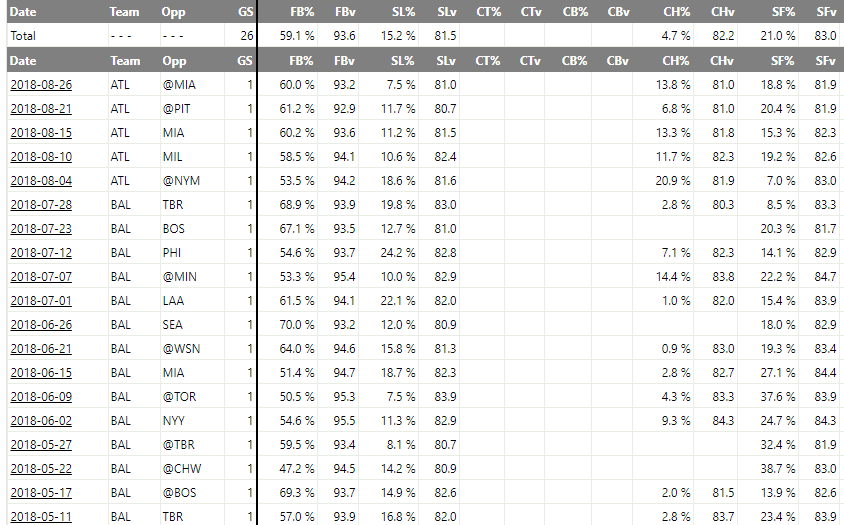Kevin Gausman Finding Success Through Consistent Pitch Selection

In 2018, it is perfectly common to see multiple pitchers throw 100 MPH on the same night, in the same game for the same team. Velocity will likely always impress fans and scouts, as velocity is the baseball equivalent of a bolt of electricity leaving a pitcher’s hand before smashing into the catcher’s glove. While it is certainly thrilling to see triple digits pop up on the radar gun, some pitchers benefit from slowing their game down.
Most recently, Kevin Gausman seems to have benefitted from reducing his velocity. Since joining the Braves, he’s posted a dominant 1.66 ERA. Three of his six starts have come against the struggling Mets and Marlins.
However, his two best starts as a Brave came against the contending Brewers and competitive Pirates. Against Milwaukee, he threw eight innings of one-run ball with eight strikeouts. In Pittsburgh, he worked eight scoreless innings and most recently, he worked 6 innings while giving up just one earned. When he left Baltimore for Atlanta, he had a 4.43 ERA. He’s dropped that mark down to 3.78.
Since joining the Braves, Gausman’s opponent batting average against has dropped from .281 to .184. He’s also benefited from pitching for a contender, as he has his run support per 9 innings is 6.19, compared to the 4.06 average runs of support he received as an Oriole. He’s striking out batters at a lesser rate, but he’s also walking fewer batters.
How has he managed this success? Some may claim it’s due to leaving the hitter-friendly Camden Yards, which may be true, as his HR/9 rate has dropped from 1.52 in Baltimore to 0.28 in Atlanta. But this may be more correlation than causation, as his groundball to fly ball ratio since joining the Braves is the highest it has been since May, meaning pitching in a bigger ballpark isn’t necessarily helping Gausman keep more balls in the park since he’s producing fewer fly balls regardless.
It’s no surprise to see that Gausman has been throwing more splitters, traditionally a groundball-inducing pitch, since joining the Braves. Interestingly, he’s throwing the splitter less frequently, but he’s also throwing it at a slower rate than usual. As seen in the image from Fangraphs below, the rightmost column shows Gausman’s average splitter velocity (SFv). Most of his splitter velocity averages from games with the Orioles are about 83-84 MPH. As a Brave, that average is about 82 MPH.
In fact, it looks as though Gausman’s average velocity is dropping across the board. His average fastball velocity this year is 93.7, the lowest of his career by more than one mile per hour, and far cry from his rookie season when he averaged 96.7 MPH.
Perhaps this drop in velocity is due to the heavy workload which comes from pitching an entire season, or maybe it’s an intentional strategy to help Gausman’s control, as his 67.5 strike percentage with the Braves is the highest of his career.
The graphic above also suggests that Gausman is finding success through pitch usage consistency. Aside from a couple outliers, Gausman has thrown his fastball, slider, changeup, and splitter at a consistent rate throughout his five starts as a Brave. He has used his fastball approximately 60% of the time in all of his starts in Atlanta, as opposed to his time in Baltimore, where his usage fluctuated wildly from 47% to 70%.
Gausman seems to have finally found some consistency and provides a viable option for Atlanta as a potential playoff starter. He’s also under control through 2020, and if he keeps up what he’s already done for his new club, he will be a significant piece of Atlanta’s exciting young team.
-Mike Gonzalez













